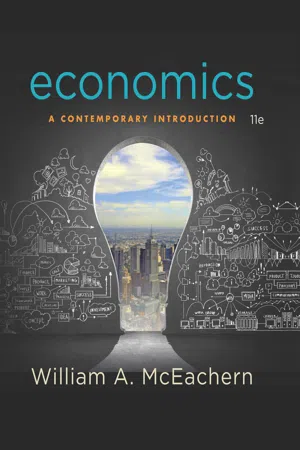
- English
- PDF
- Available on iOS & Android
About this book
Gain a strong understanding of economic principles with the hundreds of lively examples found in McEachern's ECONOMICS: A CONTEMPORARY INTRODUCTION, 11E. This book draws on what you already have observed through your life experiences to help explain economic concepts, choices, institutions, and events. Interesting case studies in the book and online, the latest research findings, and focused examples offer genuine insight into how economic principles work in today's world. A friendly writing style is enhanced by learning features that make the material clear and more direct. Understandable graphs and exhibits include captions that summarize key points for review, color-coded curves, and helpful labels for clarification. More challenging graphs in the book are built one step at a time using new Progression Graphs online software. Powerful learning tools, such as online Aplia® and MindTap, further improve your understanding of economics and its relevance to your success.
Frequently asked questions
- Essential is ideal for learners and professionals who enjoy exploring a wide range of subjects. Access the Essential Library with 800,000+ trusted titles and best-sellers across business, personal growth, and the humanities. Includes unlimited reading time and Standard Read Aloud voice.
- Complete: Perfect for advanced learners and researchers needing full, unrestricted access. Unlock 1.4M+ books across hundreds of subjects, including academic and specialized titles. The Complete Plan also includes advanced features like Premium Read Aloud and Research Assistant.
Please note we cannot support devices running on iOS 13 and Android 7 or earlier. Learn more about using the app.
Information
Table of contents
- About the Author
- Brief Contents
- Table of Contents
- Preface
- Ch 1: The Art and Science of Economic Analysis
- Ch 2: Economic Tools and Economic Systems
- Ch 3: Economic Decision Makers
- Ch 4: Demand, Supply, and Markets
- Ch 5: Elasticity of Demand and Supply
- Ch 6: Consumer Choice and Demand
- Ch 7: Production and Cost in the Firm
- Ch 8: Perfect Competition
- Ch 9: Monopoly
- Ch 10: Monopolistic Competition and Oligopoly
- Ch 11: Resource Markets
- Ch 12: Labor Markets and Labor Unions
- Ch 13: Capital, Interest, Entrepreneurship, and Corporate Finance
- Ch 14: Transaction Costs, Asymmetric Information, and Behavioral Economics
- Ch 15: Economic Regulation and Antitrust Policy
- Ch 16: Public Goods and Public Choices
- Ch 17: Externalities and the Environment
- Ch 18: Poverty and Redistribution
- Ch 19: Introduction to Macroeconomics
- Ch 20: Tracking the U.S. Economy
- Ch 21: Unemployment and Inflation
- Ch 22: Productivity and Growth
- Ch 23: Aggregate Demand
- Ch 24: Aggregate Supply
- Ch 25: Fiscal Policy
- Ch 26: Federal Budgets and Public Policy
- Ch 27: Money and the Financial System
- Ch 28: Banking and the Money Supply
- Ch 29: Monetary Theory and Policy
- Ch 30: Macro Policy Debate: Active or Passive?
- Ch 31: International Trade
- Ch 32: International Finance
- Ch 33: Economic Development
- Glossary
- Index